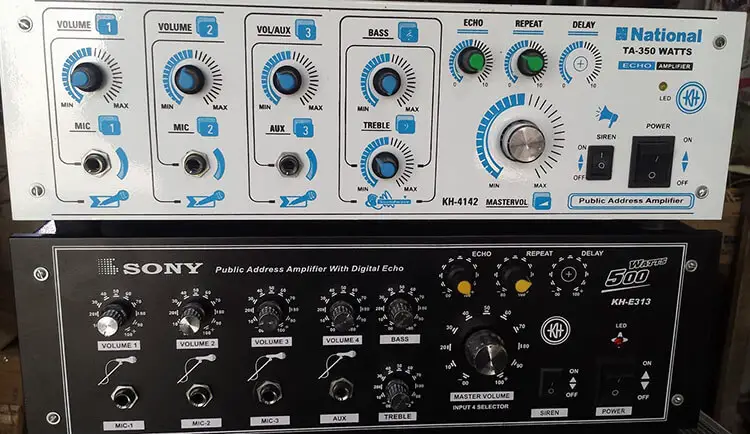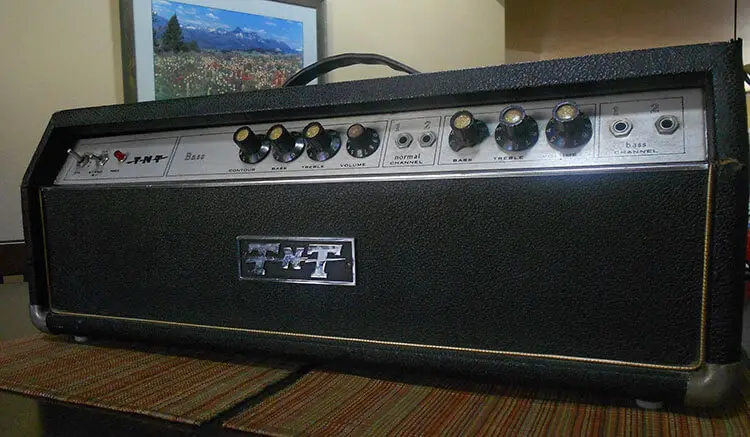Connecting multiple amplifiers may initially sound like risky business initially when you think about it, but as you learn things, you’ll realize that it’s actually easy. Most enthusiasts use multiple amplifiers to either have a louder musical experience or have each for their speakers and the subwoofer.
More often than not, it is an excellent decision to connect multiple amplifiers because why wouldn’t you use that old amplifier hanging around if you have the option to better your overall setup. You need to have a clear idea about all the things like setup, input, outputs, and plugs that are required for this process.
So, without further ado, let’s start our discussion,

Tools to have:
- XLR Cable
- TRS Cable
- Label Maker
- 6.5 mm to 3.5 mm AUX adapter
- XLR Male to TRS Cable
Steps to connect multiple amplifiers to one source
I will go through a few steps to give you a clear understanding of how to connect multiple amplifiers. You may find other steps that might work, but I will discuss the things I have experienced and knowledge.
How to connect amplifiers
First and foremost comes the basic part, you need amplifiers for two tasks on your system. So, you need to get amplifiers based on how many speakers you have. If you have a 10.1 setup, you should have a 5-channeled two amplifiers. Your setup should correspond with your amplifiers.
Steps:
- Take out your XLR cables and locate the ports at the back of your receiver. The pre-out connectors.
- You should plug in the speakers in accordance with the type of speakers. If you have ten speaker setup, then for the first amplifier, you should plug the front left and front right, then the center. After that, surround right and surround left.
- For the next amplifier, you may connect the surround left and right if you have those speakers. If not, connect the height 1, right, and left and then height 2, right, and left. Finally, you will then connect the subwoofer 1 or 2 depending on if you have previously connected or not.
- Make sure you are aware of the channels to which you connect the types of speakers.
- You may have them on your amplifier if you want to connect with RCA cables. RCA ports will have similar labels to the XLR ports.
- Lastly, turn on the trigger cable that will let you turn on your amplifiers through the AVR. Make sure your amplifiers have input and outputs. Your amplifier may have just input.
Note: Another way to connect two amplifiers can be through a splitter. If you’re out of ports, simply connect the RCA male splitter to the port and connect the two amplifiers. But bear in mind the power will be shared.
Using Bridged Mode (Daisy Chains)

If your ports are not there or occupied by other devices, then you try using the bridged mode to connect the amplifiers. You can take one of your amplifiers and then daisy chain all of them to the same source. It is an excellent way to connect multiple amplifiers.
The daisy chain is basically creating a chain of signals which is going one along with the other. Bear in mind that the daisy chain consumes a lot of power and might be hazardous if the precautions are not met.
Steps:
- For bridged mode, you should not have a stereo sound setup but, instead, get a mono sound. So, turn on the bridged mono option along with parallel.
- If you have a male-to-male XLR cable, then connect them to all the channels of the speakers, that’s like a chain. But, more often than not, people don’t necessarily have XLR male-to-male cables as they are hard to find, and you are increasing your cost.
- So, you can use your XLR to TRS cable to create the bridge. You will connect the TRS port output of channel two to channel one output to the XLR port input.
- Follow the sequence of connecting the cable, making the daisy connection to all the amplifiers. After that, run your test, and you will see that one signal coming through a single amplifier going across all the amplifiers.
Note: You may be wondering why the channel’s output is not input. This confusion is understandable because it is supposed to be input. The reason behind this is that the setting has been changed to parallel mode, and the connection becomes an input connection.
Applying Aux Signal Splitting
This solution may be specific to headphone amplifiers. If you are wondering if headphone amplifiers can split onto other amplifiers, then you’re at the right place. The plugs may be for headphones it is possible that if you have the cables, attach the input port with the auxiliary cable, then connect all the cable aux cables with the amplifiers.
- You may require a stereo adapter (6.5 mm to 3.5 mm) since the port and the cable are too small.
- With the splitter, make sure you have the correct voltage so that the signal gets equally divided among all the amplifiers.
- You will then see that you can control the rest of the amplifiers with that single amplifier you use as the primary source.
Applying Line Output Converter (LOC)
This is a solution for those who mostly have cars, as the device is made to fix solutions primarily for car sound issues. But regardless of your device, you will be able to use a LOC.
A line Output Converter converts the speaker level signal that we get from the pre-amplifier to the speakers to an RCA level signal which we can use to connect the amplifiers. Your device is probably out of RCA and XLR outputs. So, to create RCA ports, you can use a Line Output Converter.
After attaching the speakers to the LOC, simply connect the RCA cable that will draw the signal to your amplifier. Connecting through a LOC will help you run all the RCA signals efficiently.
Using Amplifier Switch
If you want to use the amplifier separately based on the sound you prefer to listen to other than the main reasons I have spoken about above, then I think an amplifier switch may be ideal for you. Because based on your preferences, you can change the amplifier with the switch.
- You will find sections based on the amplifiers and the speaker. Connect the speaker cables and speaker labeled part.
- Then connect the first amplifier to Input A and the second to input B. There are ways to build your own switch, you can proceed with that if you want to cut some costs, but that is a conversation for another day.
- Other ways can be through using an active crossover, but that is rather complicated and has a lot of openings for errors. Its job is to balance out the high and low frequencies. It’s a costly option as you will require a high-quality crossover that syncs with your system, which naturally requires you to get premium-level amplifiers. It is better to seek for a professional’s hand to desire this level of sound experience.
Note: There are ways to build your own switch, you can proceed with that if you want to cut some costs, but that is a conversation for another day.
Things to remember:
- If you are using an AVR with pre-outs then you’re supposed to use RCA cables, not XLR.
- To easily remember the cables and locate your speaker wires, it is wise to label the cables.
- I don’t recommend using a splitter jack as you will be able to connect two amplifiers with one jack with the splitter, but that will make you lose a lot of sound quality, which will hamper your experience. But, if the sound quality is not your concern, you should go for this effort.
- Before turning it on, make sure you cross-check everything that you have done so far. It is incredibly important to double-check because any sort of error can completely ruin your setup. Like, you are checking the right source to get the audio.
- You create a system that is likely not in accordance with your devices, so chances are, through some errors, a fuse might get broken or overheated. If you notice any unusual behavior, then chances are that something is wrong. Either reset your system or locate the device which is getting overheated.
- Bear in mind that if any of the steps require disassembling your speakers or receiver, your warranty will most likely become void. That’s your liability in the end.
Frequently Asked Questions
Is it possible to attach multiple amps on one speaker?
With an external device, yes, but without an external device, the speakers are likely to mismatch the signals coming from the two amplifiers causing the speakers to run abruptly with all sorts of distortions and potentially risking the life of your amplifiers. But, with a switch, it is possible.
What’s the purpose of Bridging amplifiers?
When you seek not to have any stereo output from your setup but rather want mono output, then it is wise to bridge amplifiers. You can bridge amplifiers for more excellent sound in your large home theater setup,
Is it possible to use two amps with one subwoofer?
Firstly, you need to make sure that you have two similar amplifiers, or else your sound won’t be good to listen to. Secondly, it only works if the subwoofer has dual voice coils.
Wrap Up!
Thus, I hope, I have made enough sense for you to let you grasp all these steps to connect multiple amplifiers at one source perfectly. Connecting multiple amplifiers to one source is actually relatively easy. The concept may sound complicated to you, but if you have gone through what I have discussed so far, it would feel like a walk in the park for you. Before you dive into all the steps, I advise you to go through the things to remember part, as I have mentioned some cautionary details and insights there.
Thank you for your time and I’ll you in some other issue.
